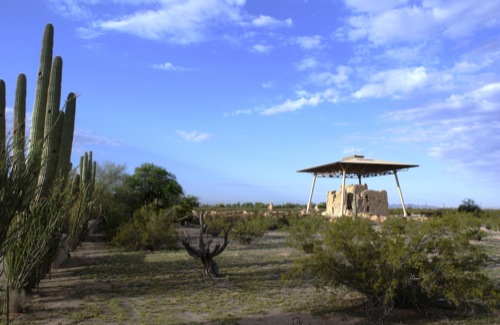
Casa Grande Ruins National Monument, courtesy NPS
Casa Grande Ruins National Monument
Coolidge, Arizona
Credited as the nation’s first archaeological preserve, the Casa Grande Ruins National Monument was created in 1892 to preserve an ancestral Sonoran Desert people’s community and “Great House.” The site was declared a national monument shortly after the National Park Service was established in 1918 and stands today as a proud reminder of the history of the desert.
Six different federally recognized American Indian tribes are able to trace their ancestry to the people of the Sonoran Desert, so visitors who explore the Casa Grande Ruins in this region will most likely pass through at least one American Indian reservation on their way to the monument.
“When we began meetings with representatives of the tribes regarding interpretation of the monument in 2009, our eyes were opened to very different perspectives on the resources we protect,” said Carol West, chief ranger for the Casa Grande Ruins National Monument. “Working with several of these articulate, insightful and patient people has been a tremendously exciting and enriching experience.”
www.nps.gov/cagr
Rocky Mountain National Park
Estes Park, Colorado
Long before the Rocky Mountain National Park’s official inauguration in September 1915 — approximately 10,000 years by recent carbon-dating estimates — the Ute and Arapaho Indians used the region of the park as a sort of dividing line and battleground between the two tribes. But the area near Estes Park seems to have been mainly used as a coming-of-age location for young tribesmen.
“The Native Americans that used to indulge in this valley considered this area a very sacred place and held a ritual here called the vision quest,” said Dave Cosby, adventure guide and senior driver for the off-road division with Rocky Mountain Rush Tours. “On the quest, the young man would bring a token from home and come to Old Man Mountain in Estes Park to deprive himself of food, water and sleep until he had a vision. He’d then go back to the elders and have them interpret the dream. We’ve found geological rocks as far as northern Wyoming that have been brought into the area for these quests.”
Visitors can explore the park in one of Rocky Mountain Rush Tours’ 15-seat excursion jeeps or travel on foot to walk the same grounds the natives walked many years ago. Along the way, they will see the scenic ponderosa pines and aspen trees, referred to by the Native Americans as the “eyes of the spirits of the forest,” and, possibly, some wildlife.
www.nps.gov/romo











